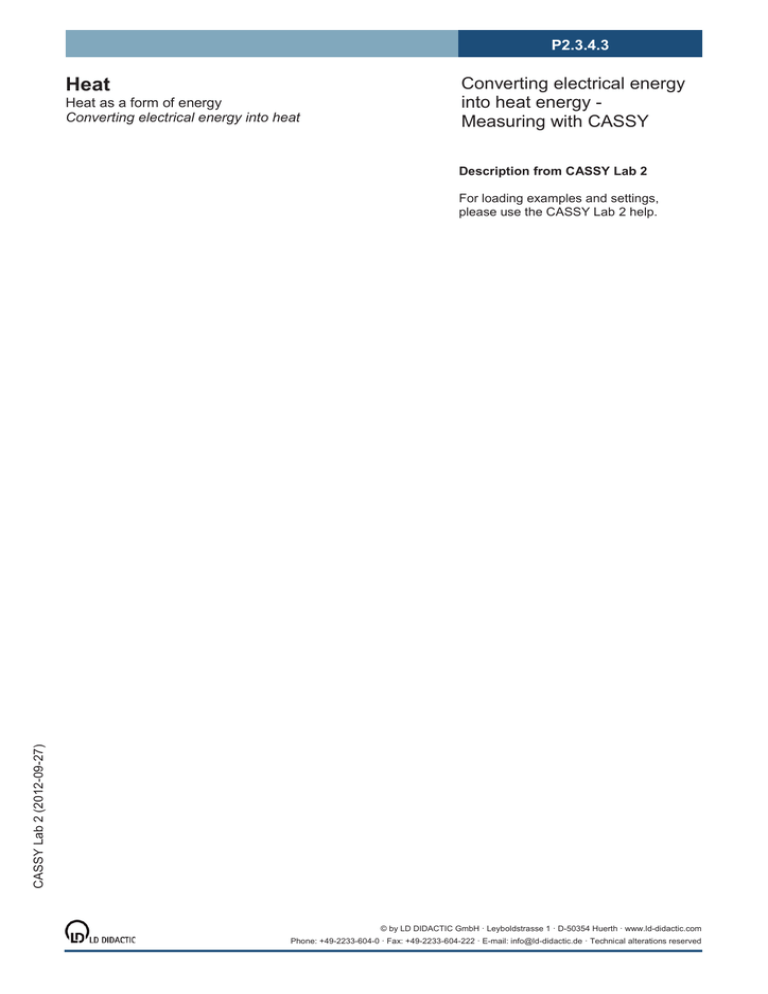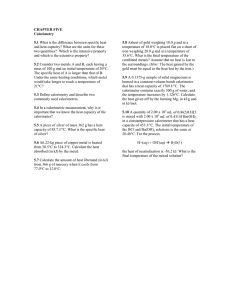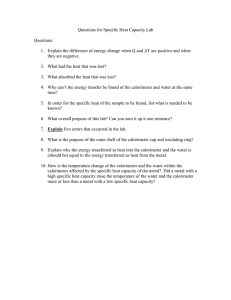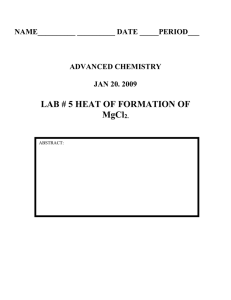Converting electrical energy into heat energy
advertisement

P2.3.4.3 Heat Heat as a form of energy Converting electrical energy into heat Converting electrical energy into heat energy Measuring with CASSY Description from CASSY Lab 2 CASSY Lab 2 (2012-09-27) For loading examples and settings, please use the CASSY Lab 2 help. © by LD DIDACTIC GmbH · Leyboldstrasse 1 · D-50354 Huerth · www.ld-didactic.com Phone: +49-2233-604-0 · Fax: +49-2233-604-222 · E-mail: info@ld-didactic.de · Technical alterations reserved CASSY Lab 2 Conversion of electrical energy into thermal energy Alternatively: Safety note Danger of implosion: the Dewar vessel is a thin-walled, highly evacuated glass vessel which can break under mechanical stress. Do not knock or drop the Dewar vessel. Do not allow any hard objects to fall on or into the glass mantle. Do not scratch the glass mantle with sharp objects. © by LD DIDACTIC GmbH · Leyboldstrasse 1 · D-50354 Huerth · www.ld-didactic.com Phone: +49-2233-604-0 · Fax: +49-2233-604-222 · E-mail: info@ld-didactic.de · Technical alterations reserved 208 CASSY Lab 2 Experiment description Energy is a measure of stored work. It occurs in different forms, which can be converted one into the other. In a closed system, the total energy is conserved in conversion processes. therefore the energy is one of the fundamental quantities of physics. In this experiment, the equivalence of electrical energy E el and thermal energy Eth is established experimentally. The supplied electrical energy Eel is converted into heat Eth in the heating coil (or heating spiral). This leads to a temperature rise in the calorimeter (or water, in which the heating spiral is immersed). As the current I and the temperature ϑ are measured simultaneously as functions of the time, the constant voltage U being known, the two energy forms can be registered quantitatively in units of wattsecond (Ws) and Joule so that their numerical equivalence can be demonstrated experimentally: Eel = Eth. Equipment list 1 1 Sensor-CASSY CASSY Lab 2 524 010 or 524 013 524 220 1 1 Temperature box Temperature sensor NiCr-Ni or NiCr-Ni adapter S Temperature sensor NiCr-Ni, type K 524 045 666 193 1 1 1 1 1 1 524 0673 529 676 Voltage source, 0...12 V, e.g. Variable extra-low voltage transformer S Calorimeter with connecting cables, e.g. copper calorimeter with heating pair of connecting cables for calorimeter or aluminum calorimeter with heating pair of connecting cables for calorimeter or large aluminum calorimeter with heating pair of connecting cables for calorimeter or Electric calorimeter attachment Dewar vessel Beaker, squat shape, Duran, 250 ml Graduated cylinder, plastic base, 250 ml Pair of cables, 50 cm, red and blue Connecting lead, 50 cm, black Pair of cables, 50 cm, red and blue PC with Windows XP/Vista/7 521 35 388 02 388 06 388 03 388 06 388 04 388 06 384 20 386 48 664 103 665 755 501 45 501 28 501 45 Experiment setup with calorimeter (see drawing) · · · · · · Set up the calorimeter so that the bore points upwards and pour water into the opening. Insert the gasket in the bore, and hold it with the locking screw. Insert the temperature sensor as deeply as possible in the opening of the calorimeter, and tighten the locking screw of the calorimeter. For the current and voltage measurement, connect the CASSY to the variable extra-low voltage transformer S as shown in the drawing. Connect the heating coil of the calorimeter to the input A of the Sensor-CASSY (plug the large banana plugs together and connect one cable to the blue safety socket and one cable to the red safety socket). Connect the temperature sensor to the input B of the Sensor-CASSY via the temperature box (socket T1) for measuring the temperature ϑB11. Experiment setup with electric calorimeter attachment (see drawing) · · Using the graduated cylinder, pour approx. 200 ml of water into the Dewar vessel. Put the electric calorimeter attachment into the Dewar vessel, and fix the cover with the aid of the springs. © by LD DIDACTIC GmbH · Leyboldstrasse 1 · D-50354 Huerth · www.ld-didactic.com Phone: +49-2233-604-0 · Fax: +49-2233-604-222 · E-mail: info@ld-didactic.de · Technical alterations reserved 209 CASSY Lab 2 · · · · Immerse the temperature sensor with the sealing washer in the Dewar vessel through the rubber stopper. The temperature sensor has to be held by the sealing washer so that the tip of the sensor is below the heating spiral. However, the tip of the temperature sensor must not touch the bottom of the Dewar vessel. For the current and voltage measurement, connect the CASSY to the variable extra-low voltage transformer S as shown in the drawing. Connect the heating spirals in series to the input A of the Sensor-CASSY (lay a cable from one heating spiral to the red safety socket and another cable from the other heating spiral to the blue safety socket, and connect the free connectors with a black cable). Connect the temperature sensor to the input B of the Sensor-CASSY via the temperature box (socket T1) for measuring the temperature ϑB11. Experiment note If the experiment is carried out with the electric calorimeter attachment, the water has to be stirred while the voltage is switched on in order that the warming takes place uniformly. Slowly move the stirrer up and down during the measurement. Carrying out the experiment · · · · · · · Load settings Select the Voltage UA1 as measurement quantity in Settings IA1. Switch the variable extra-low voltage transformer S on, and set the voltage UA1 to approx. 9 V (calorimeter) or approx. 4 V (electric calorimeter attachment). Read the exact value of UA1, and enter it in Settings U as parameter. Switch the variable extra-low voltage transformer S off, and select the Current IA1 as measurement quantity and 0...2.1 A as range in Settings UA1. When the initial temperature ϑB11 is constant, start the measurment with . Switch the variable extra-low voltage transformer S on, and switch it off again at the desired final temperature ϑB11. Stop the measurement with when a constant final temperature is reached. Evaluation The temperature ϑB11 and the current IA1 are already displayed graphically as functions of the time during the measurement. The thermal energy Eth = C · (ϑB11 - ϑ1) is plotted against the electrical energy Eel = ∑ U·I·Δt in the prepared diagram Evaluation. The heat capacity C depends on the calorimeter used and has to be entered in the Settings C according to the following table: Calorimeter Copper (388 02) Aluminum (388 03) Aluminum, large (388 04) Electr. calorimeter attachment (384 20) with Dewar vessel (386 48) Heat capacity C/(J/K) 264 + 4.2 (for 1 g water in the bore) 188 + 4.2 (for 1 g water in the bore) 384 + 4.2 (for 1 g water in the bore) (mH2O/g + 24) · 4.2 (with the mass of the water in g and the water equivalent mD = 24 g of the Dewar vessel) The equivalence of the electrical energy Eel and the thermal energy Eth can be confirmed by fitting a line through the origin. Usually the slope of the straight line through the origin is somewhat smaller than 1 because of heat loss due to emission of heat radiation. This becomes particularly obvious in the case of long measuring times, where the measuring data deviate significantly from the straight line through the origin. Hint As an alternative, the measurement can be evaluated manually: determine the mean value of the initial temperature ϑ1 and the final temperature ϑ2 (select Draw Mean with the right mouse button), and calculate the thermal energy Eth = C · (ϑ2 - ϑ1). Determine the time of electrical energy supply with Set Marker → Measure Difference, calculate Eel = U · I · Δt, and compare it with Eth. © by LD DIDACTIC GmbH · Leyboldstrasse 1 · D-50354 Huerth · www.ld-didactic.com Phone: +49-2233-604-0 · Fax: +49-2233-604-222 · E-mail: info@ld-didactic.de · Technical alterations reserved 210





